Tom's Guide Verdict
iPhone users have better options, but Photojojo can be a good choice for a cheap Android camera enhancement.
Pros
- +
Works with almost any phone, not just iPhones
- +
Lenses sold individually, for just $20-30 each
- +
Sturdy aluminum housing
Cons
- -
Mediocre image quality
- -
Lenses can fall off easily
- -
Adhesive mount leaves sticky residue
- -
Severe pincushion effect with telephoto lens
Why you can trust Tom's Guide
Design: Magnets, how do they work?
Photojojo advertises its product as pro-lenses for your phone. While they offer new features, professional they are not. We tested the telephoto, fisheye and wide-angle/macro combo lenses. The wide-angle and macro lens are a 2-in-1 combination, where the wide-angle lens unscrews to reveal the macro underneath. Each lens features a durable aluminum housing.

Unlike other kits that include mounts or cases with threaded screws, Photojojo uses adhesive metal rings or strips and magnets inside the lenses. This gives the Photojojo lenses the flexibility to attach to a wide variety of smartphones, but the strength of that attachment is often weak and unstable. One bonus of this setup is that it is often possible to affix the lens to the outside of a case. But again, it's an unreliable attachment.
MORE: Best iPhone Camera Lenses
Ease of Use: Apply adhesives and wait
Setup for the Photojojo system is slightly complicated for a system that seems quite simple at first. Taking photos with an iPhone provides the best-use case compared with Android phones due to the lenses' custom adhesive strip that covers the top rear of the iPhone. With Android phones, you apply a small adhesive metal ring to the case or phone directly. Then you wait a full 30 minutes for it to set, because if you don't the ring will fall off, and be lost to the place missing socks and pens go to die. And with just three rings per box, you could run out quickly.

From there you set the lens on the magnetic side of the adhesive, although you have to be careful to make sure the lens is centered. Otherwise you will be left with a blurry and misaligned picture. Since the lens is attached only through the power of magnets, a quick shake or inadvertent bump can dismount your lens and send it tumbling to the ground below, as happened several times during my review. I can easily imagine a lens falling off unbeknown and getting lost in the ether.
Quality of Images
Wide-angle, fisheye and telephoto lenses
We have included a control shot below using the stock iPhone 5s camera, so you can see how the images change with each lens.
Get instant access to breaking news, the hottest reviews, great deals and helpful tips.
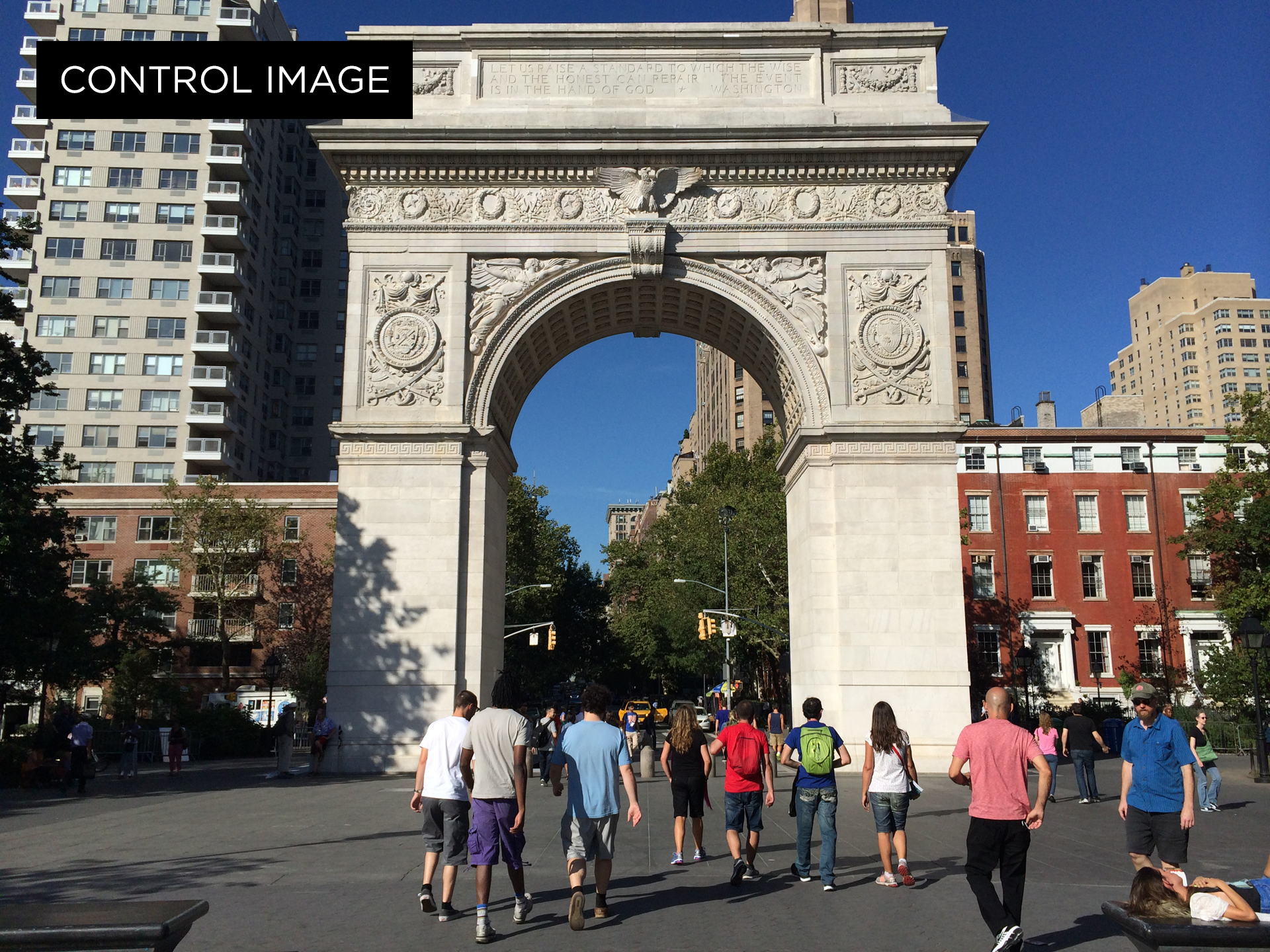
Wide angle lens: sharp
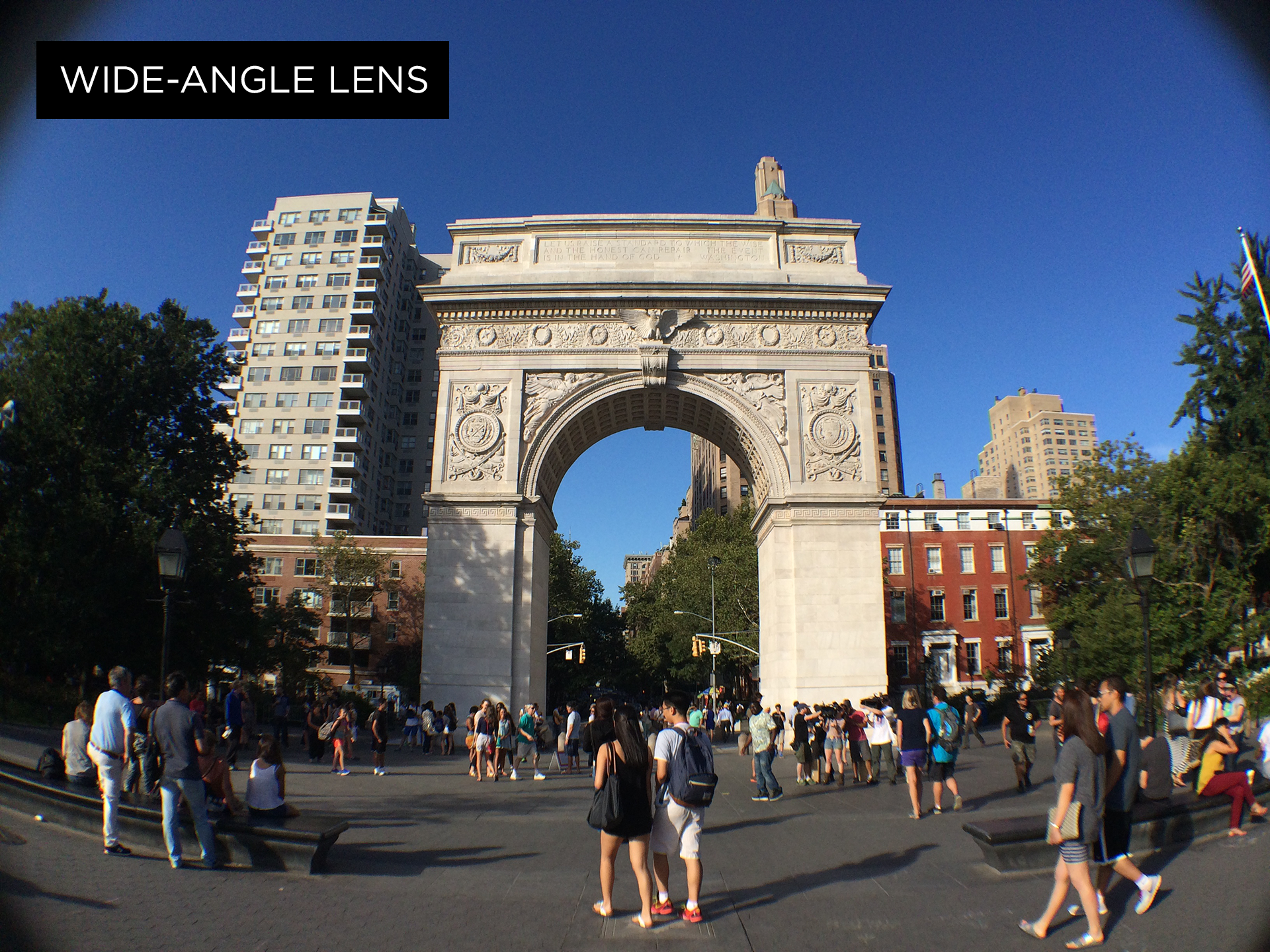
Images contained lots of detail, both on the focus point in the arch and in subjects along the edge. The results tied with the Olloclip's for least distortion among wide-angle lenses. The downside is that even with a perfectly placed lens, there is still some cropping in the corners, unlike with the Olloclip.
Fisheye lens: smaller view
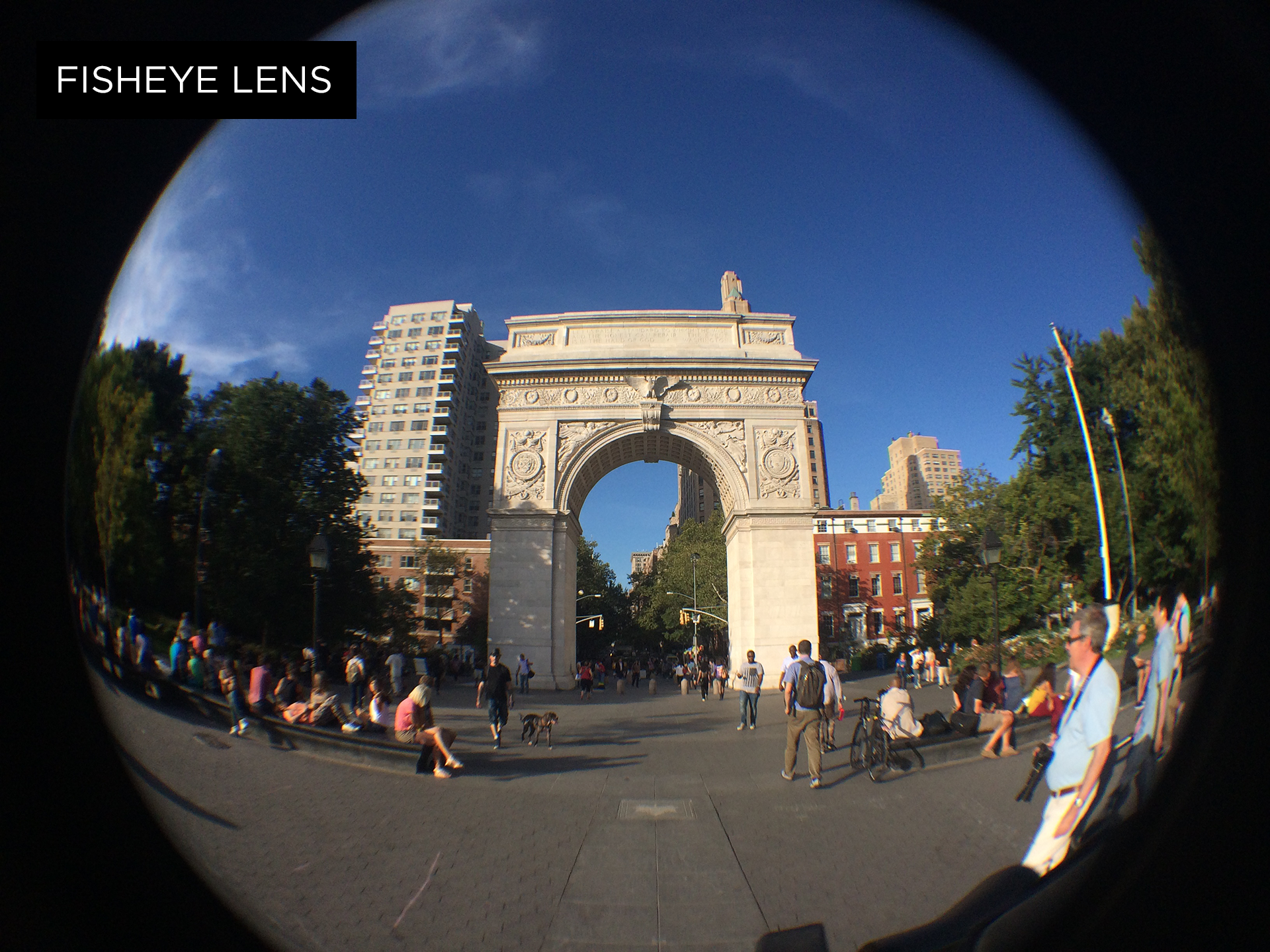
The Photojojo fisheye lens produced solid images without any major flaws. Subjects in the center are relatively crisp, although the images are slightly smaller than what you get from other fisheye lenses, without an increase in field-of-view.
Telephoto lens: pinched pictures
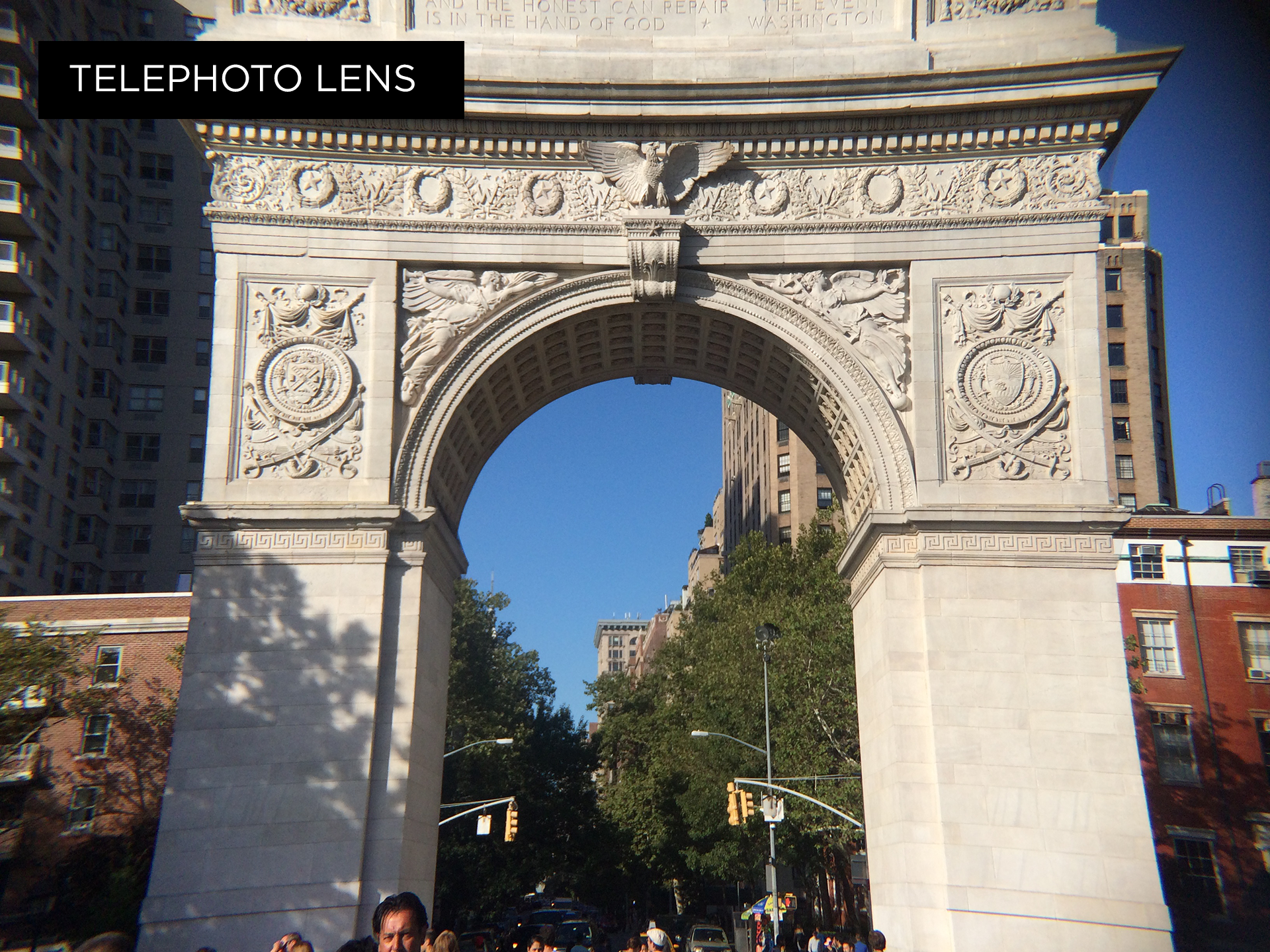
Pictures taken using the Photojojo telephoto lens are almost unusable. Images suffer a severe pincushion effect in which they appear to be squeezed in from the sides. This effect is exaggerated as your subject gets farther away, which defeats the purpose of a telephoto lens in the first place.
Starting point: macro
Below is a photo of a $2 bill using the stock iPhone 5s camera to compare with results from the Photojojo macro lens.
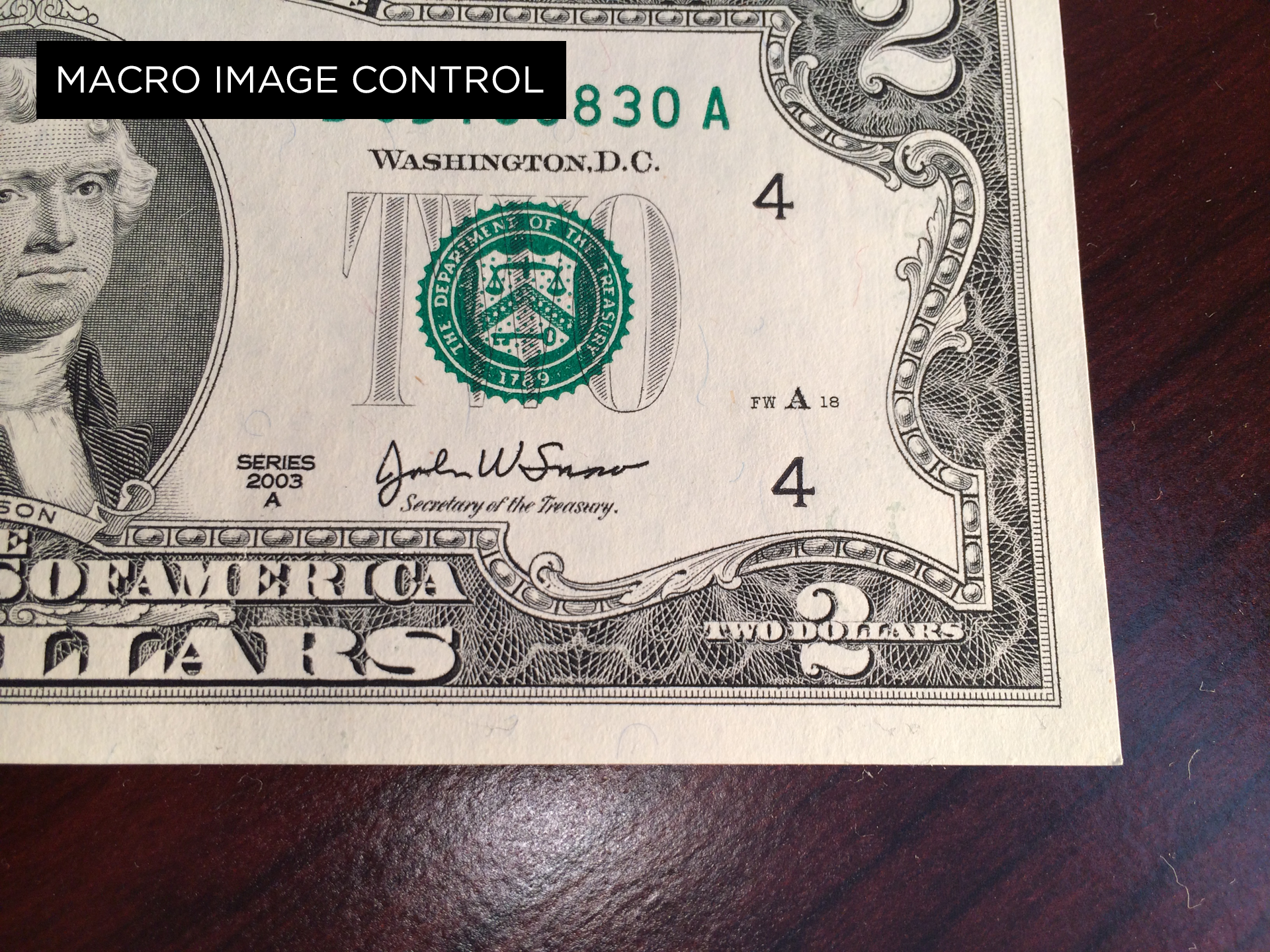
Macro lens: supersharp
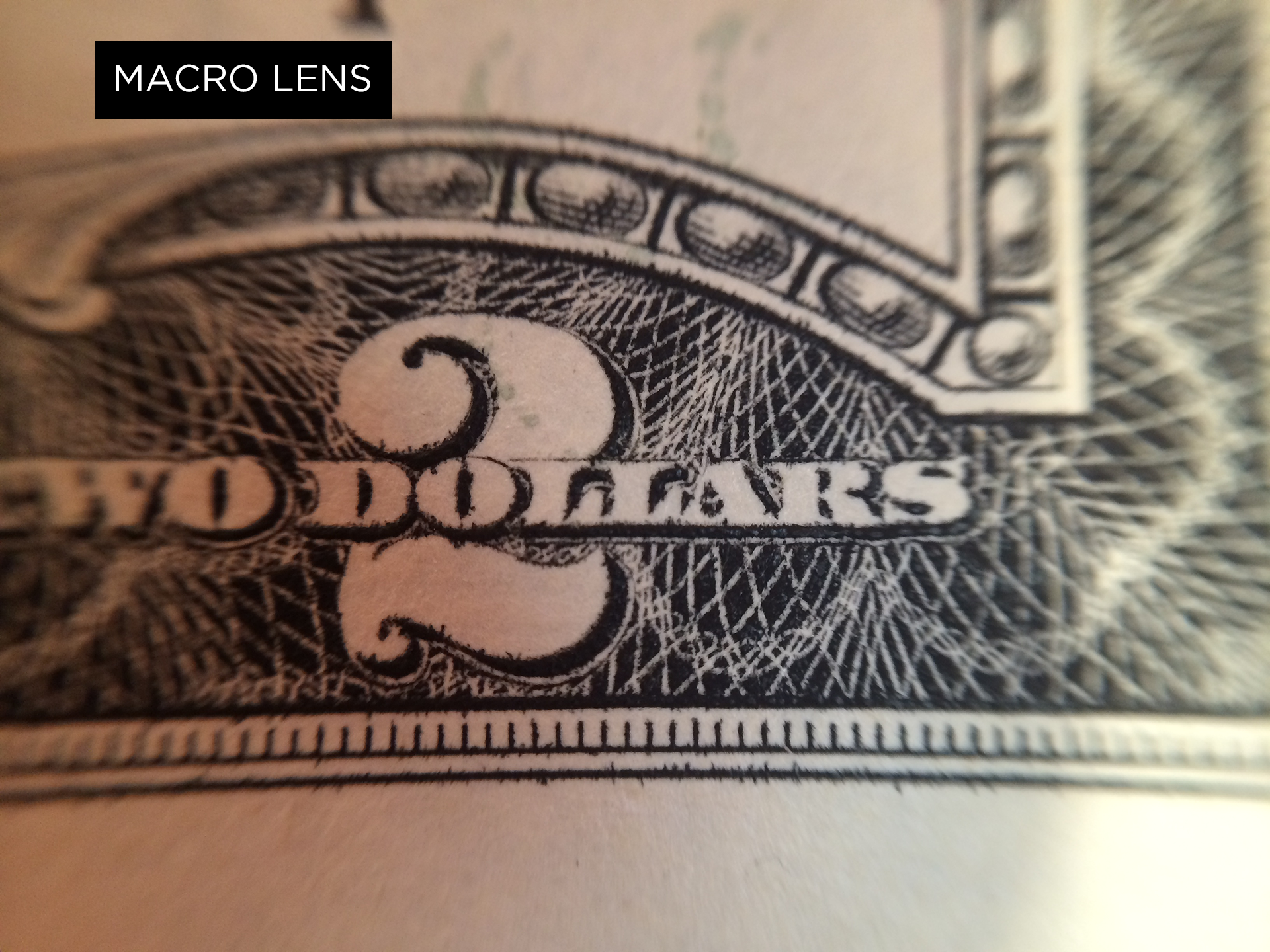
I was pleasantly surprised by the quality of images the Photojojo macro lens produced, tying the wide angle for my favorite lens of the bunch. Images showed good detail and a large area of sharp focus in the middle.
Bottom Line
With each lens priced between $20 and $30, buying a single lens is a simple and inexpensive affair. Unfortunately, compared to multi-lens kits like those from CamKix ($44) and Olloclip ($70), Photojojo lenses begin to feel like less of a deal when you buy several of them. With the Photojojo, you pay for the flexibility to upgrade your lens on a great variety of products at the cost of a secure grip.
The downside is just mediocre image quality, and lenses that can easily be lost or dislodged. iPhone users can probably ignore these lenses, as they have a wide variety of competing lenses to choose from, but for Android or Windows Phone users looking to expand their photo-taking tool bag, Photojojo provides an inexpensive solution to whet your appetite without letting you get too full.
- Olloclip 4-in-1 Phones Lens System Review
- Manfrotto Klyp+ iPhone Lens Kit Review
- CamKix iPhone 5/5S Camera Lens Kit Review
Sam is a Senior Writer at Engadget and previously worked at Gizmodo as a Senior Reporter. Before that, he worked at Tom's Guide and Laptop Mag as a Staff Writer and Senior Product Review Analyst, overseeing benchmarks and testing for countless product reviews. He was also an archery instructor and a penguin trainer too (really).
-
Fortitude That's my cousin data:image/jpeg;base64,/9j/4AAQSkZJRgABAQAAAQABAAD/2wCEAAkGBxMSEhUUExMVFRUXGBgaGRgYGR4aHBsgHx4cHSAcHxwcHSggHB4lHxogITUhJiorLi4uGB8zODUuNygtLisBCgoKDg0OGhAQGywkICQsLC8sMiwtMCwsLSwsNywsLDQsNywsLCwsLCwsNCwtLCwsLCwsLCwvLCwsNSw3LjIsLP/AABEIAMwA9wMBIgACEQEDEQH/xAAcAAEAAgMBAQEAAAAAAAAAAAAABgcDBAUIAgH/xABQEAACAQMCAwUEBgYFCAcJAAABAgMABBEFIQYSMQcTQVFhIjJxgRRCUpGhsSNicoKSwRUzQ7PRCCQlNVOistJEY3ODk+HwNFR1lKPC0+Lx/8QAGgEBAAMBAQEAAAAAAAAAAAAAAAECAwQFBv/EADIRAAIBAgQEAwcEAwEAAAAAAAABAgMRBBIhMQVBUWEicYETFDKRobHwFSPR4UJywQb/2gAMAwEAAhEDEQA/ALxpSlAKUpQClKUApSlAKUpQClKUApSlAKUpQClKUApWC8vI4ULyukaL1Z2CqPiTtUE1Xti02JuSIy3UhOAsCE5PkC2Af3c0BYVKqzUe1O9jjMo0WdYhgc8z93uTj3TH/OtLUO1fUYEikl0oKkyl4z32eZRy77Lke8OuOtBYuClVVedql7bDmu9Gnjj2zIsnMN+m/d8v+9XQ0Ttn0ychXaS3Y7fpV9n+JCwA9TigLFpWG0uklQPG6ujDKspDKR5gjY1moBSlKAUpSgFKUoBSlKAUpSgFKVyNb0Bbkbz3MX/YzPH+AOPwoDr0qr9a7NLtVLWmqXrMP7Oe4kwfQOhHKfiD8utQaPi3VbSVonuZkkT3orhVk288kZZT9pWxUpXJSueiaVUuh9sRBC31vgf7aDLD4tGfaA+BarN0nVYLqMS28qSxnoyHPyPkfQ71AasbtKUoQKUpQClKUAqC8c9oa2jNbWkf0m85SSg9yIAZLSHwwN8ZHqRkVh7XON20+BYbcj6XPkJ48i9DJjz8Bnxyd+UioBwpoc91H9HtYykbkG5unyWlbOTzOeoB3Ea+O7HcmpSJSubnBPDUutzSXGqSyTRx4CxhikfMd+UBegC9cYO43NduDR4P6eihtoo447aMFgigDIUtk46nmkQZO9S/VL630axVUA9kFY08ZH6kn57k/wDkK5vZZo0ixyXk+TNdHm368uSc+nMTn4BanuT3MHbTd4tIol96WYbeJCqf/uK/fXL7XtN7qysgOkX6L/6Y/wDx1kvpP6S1uONfagtN2PhlTlj85AqY8QhNSvtJ0w3GnzADLIBIv7m5+ZXmHzptYlaWP3iq1+laXIE35oVkX1KgOPyqD9nvDNjqVi8dzAjvHIcOPZkAYAj21wcZzsdtqmnZnqYuNPi3y0Y7pv3dh968p+dRHRf9E6u8Dezb3PuHwGSSn8LEp8wadh1RXGm3F9pFzL9DdmWN37yBssrBCQSVHkB7wwQBV+cC8YQapbiaL2WXCyxk5KN5eqnwbx9CCBB+0bTHsr6PUIlyjMC48ObGCp8hImR8c+YrlXwj0i9ttVsj/o+7ISdB0Tm67eGMFgPAoy7A0aIa5ovClfgOa/aqVFKUoBSlKAUpSgFKUoBSuJxNxXaWCBrmUKW92Me1I/7KDc/HoPE1Vut9r15KSLS3jgT7cx55CPPkX2VPoealiUrl21Wvbbo9vLa/SGljiubcFoyzAGQeMWM5bPh6/E1V9/xDqNx/XX85HlGREPhhAM1yFsIweYrzMdyWJY/HJq2VllBmwhyAfOsum301pL39rKYZNubG6uB4OnRh+I8Kx0q5o1cu7s/7R4tQxDMBBdgf1efZkH2oyeoxvy9Rv1wTU6ryTPBlgAxRweeJ1OCrA52I3GDg/P0q9Oynj03yG3uSFvIh7Xh3q/7QDz8wPMEbHAzasZSViwqUpUFRSlfErYUnyBoCp+GbW21HUdQ1C87tooZPo8AkI5AEG7YO2+x3+21SHXe0iztl5LbE7jZVj2jHl7WMY9Fz8qrXsa4Ih1C2lklllXkmK4Tl39lTnLKfOrj0bhGxsvbSJQy795IeZh65bZflip0LKxDuH+ErnUJxealkLsUhIxkdQCv1E/VO58fWS9oHE/0SERQ73M3sxKu5XO3Nj8APE48jWlxF2iRqe5sR9KuG2XkBKA/Ee/5+zt5kVl4N4PeOQ3l63e3b777iPO2B4c2NsjYDYbbmfMnuzd7P+GPoNvh8GeTDSnrv4JnxC5+ZLHxr64O4gF415vlUnKr5cnKqqfgxVj86+O0TXTa2pWPeef8ARRKOuTsWHwB29SvnUc0OEaXqcNudo7i1iQnwMq5GfmQR/wB4KbkWvqa2jyf0Pqb277WtyQY2PRd/Z/hJ5D6cpNTDjvhdb+3KjAmTLRMfPxU/qt0+4+FZ+MuGUv7cxthXXeN/st6+anoR/MCotwXxe9u/0DUMxyoQqSMdiPBWb8n6H49W+pO+qPjhHihLhG07UlxKP0f6Tbnx9Vj4SDbB8diN6j3F/BN7a29xFb5ubSVSSmOZlI3VuQb8wIHtJ1xuKsLjLgmC/HMf0cwGBIBnPow+sPxHnULF7rWl+y6fSIV6MQZVA/aXDqP2th4VPkFrsTXsx1I3OlWchJJ7oISepMZMZJ+JTNSioB2FH/Q8H7U3941T+qFBSlKAUpSgFKUoBUM7SuNP6OhVYgHuZsiJT0UDrI36q56eJ+dTOvP3aqXOrzc/RYYRH+yQScfv833VKV2SldkYkZ3dpZXaWZzl5H3Y+noo6BRsABSlK0NxSlKkClKUBr3uwDfYIb5dG/3Sa+zNJDJHcwHlnhPMp8x4qfMEZGPEEjxr7dcgg9CMVg02QtGueo2PxG38qgho9NcJa/Hf2kVzHsJF3X7LDZl+RB+Oxrr1RvYtr30a7eyc4iucyReQkA9pf3lGf3R51eVZGLVhWO491vgfyrJWO491vgfyoQedeySx1SS2l+gy8kfe4b2lX2uVd91J6Y6VOouza9uSDfXpK5zyhnlPy58Kp+ANcv8AyfNXt4bKdZp4oyZ8gO6qSORN8E9Nqsi54209Bk3cJ/Ybn/BM1ZNlk3yM3DnC1tYriFPaIw0jbu3xPgPQYHpW3rWrw2kTSzNyqPvY+CqPEnyqF3/agrnu7G3luJD0JUhfjyjLH58vxrX0/gi6vpRcarIcD3YFPQeXs7IPhknxNLdRbmxwfay6neHUrheWGPK28Z6ZHiPPl3JPix2xy4rrdqGgtc24lhyZrZiw5feI2LAY3zsrD9n1qQaprNpYRjvpYoIwMKCQNh4Ko3OAOgFR/s94ja5lvElBV+9E0SnY9w6hY8g75HIcjwJApfmRm1NvgDi1b+ABiBOgAkXz/XX0P4HbyzucV8KQX6csow6g8ki+8vp6r+qfwO9RjirgGQTfS9OfupgSxjB5QT4lSdhnxU+yc+Hj+6T2k923c6lC9vKPrhTyn1K+8PlzD4U7om3NGhFdaro/syR/TLVejDJKj44LIB5MCo6A1INK7TbCYDmdoW8pFOP4lyuPiRUi0/XbacZiuIn9FcZ+YzkVr6lwvZXBJlt4mY9WA5WP7y4P40v1F1zIx2E/6ng/bm/vGqwKr/sJ/wBTwftzf3jVYFVKilKUApSlAKUpQCoX2i8Ef0gqSRMqXMQIUt7rqd+R8bgZ3DDODnY5qaUoDzVqPDN9bkiazmAH1kXvU+OY87fECuQJlzy8w5h1HQj5da9WVp6hpME4xNDFKPJ0VvzFWzF1NnmOlXpf9l2mye7C0J84ZGQfw5KfhUbv+xs/2F63wmjVv95Cn5GpzFs6KvpW7xLodzYTCK4RcsC0bocpIBjOM4IYZGx6ZHhWgjgjI6GrXLJ3PqtPT9jIvlIT9+D/ADrcrTh2mkH2lRvuyv8AhQMzXJdeWSI8ssTCSMjwZTkV6W4R15L+0huU/tF9ofZYbMvyYGvN9TbsV1/6NdyWTnEdxmSLyEgHtL+8oz+6POqyXMpNcy8qx3Hut8D+Vc/VOI7S2YLcXUELEZCySKpx54Jzit0zK8ZZGDKVJDKcgjHUEbEVQzKU7B+GbS7s53uIRIyzkAksNuRDj2SPOrOj4I02P2vosWBuS5LAfxEiqM7L9Gjnt5GcyAiXA5JXQe6p6KwB69akmuaPZ28DyypLKi4yjTSMDkgDZnx1I3PStVSk1e5V1LOxMNb7T9J08GOErKw/s7ZRy59XGE+4k+lV3qXanq+oEpYw9wh8YxzN85WAVfkF+NYdN1aySRAbCJAzKisuHYc2wyCuTv5E1YSrjYbD0q0aKfMrObjuiE8NcDlZBc30hnn6gMxcA+BZm3dh9w9akuo2sqyx3VqQtzDkDm92RD70T+h6g+B3rNq+orbwvM4JCDoOpycD4bnqdhUeteNwZER4SokcIpVuY5PTK8oPXyzWzUEspRZn4kWRovaFay8qXBNnPsDFP7IJ/UkPsOPLBz6CpFNHb3KYYRTIfA8rj+dQCRAwwwBHkRkVwdZ06wgQzSW8a4I3RAGJJwAOXByc+dZOhbZllVJ5e9munSb9wUP6jsPwJI/CtMdldkOklyB5CQf8lVrb3tjLIqMlzEXYKpM0gUk9B7MpxnGPnUgHC0HnP/8AMS/89VVKT2Zd1Wt7kk7Cf9Twftzf3jVYFV/2E/6ng/bm/vGqaXuqwQkCWaKMnoHdVz8MmsSxuUr5RwwBBBB3BG4NfVAKUpQClKUArHNMqDLsFHmxAH3msOqSyJDK0SB5VRiiHYMwBKj5navLd9fPeSFrx5JJwTzJKSOQ+KiPYKB5AVKVyUrnpk8TWQ63lt/4yf8ANWaHWrZ/duIW+Ein8jXl0afF/s1+6vw6dF/s1+6pylsjPVq3KHo6n5iuXqfFdjb5767gQjwMi838IOfwrzIulwj6g/GsyWkY6Io+QplGRkl7QOK11O6R4gwt4FZYywIMjNjmfB3AwABnf8qis5MZLjdT748v1h/MfOtulXSsXSsj8RgQCDkHoa0bw8s0T+Byh+fT8a/HUwHmUZiPVR9T1Hp6VnuohLGQD13U+vgaEmzWtfStGFljJWWJ0eMjchgRj41pyiRlDozjGzoDvkbHGfH0re0W2ElzZgSs6NOmQQPqnmwdvSq1JZacp9FcznUS0fMkw0yQySBbaG9uUCyXctz7XM7b9zH4AhfHpsOlSDRtReziF1YB2tGDd/ZHqng7RA+5IhzlOjY+BrWXVJbOxFwkPemS5kaQZwcSSOFOfP3F+dZeGtbikvZFi5kEyGSSJ1KvHMhVWyp+2jKc9MxnxJr5P3mvFurHk3z3t8Sa5dVtZaGRW/CPG5sYWiEAk5nL5L8vUKMY5T9n8asaz1G/uIVcWERSRcgPON1PmCniPzqn4LZZL1Yz7rThT8C+Pyr0Nd3QVZVjwZI4+YJ8m5dvIlCPlXq8R4nWw6hGlbXr0IlFEMsbaWOYrFptkswGSFmXnUHx2TKg49K6qXmonOLOA4ODi5B38vc61KeG7NYraIKcllV2fxdmALOT4kk5qKPqT3V/dpbKqzWoQDfC3C9Hjk8AQ2yv9X4E11TqYxQ8E43/ANdPudM8IlFO+pFdS7SJYnaKaxCsMhkZ/wD9MEH7jXKtOPoIm549NhRvtKwB+R5NqsPivhyPUrYMF5JguY2YYKn7D+mdiPA/jDezngQsxuLtMKjEJG31mU4LMPsgjGPEg+A356fG4ui51NJR0a79vzQ5ssSSaPrl/cxiVLBAje7zzcpI8wCmcetfj6lcT80JtrOX7Uf0pHO3mvL4Vu69r0UUKXE6l7aSRY441IAdTnMr+acoPKnQjBPvezKzodtyciwxouxBjUIV8ipUAgjzFa0q+NqQzSajfZWv89TenhMy6EEtdKuY2DpplsGByCbjJHwypx8q4V12oSRO0b2YV0Yqw73oQcH6lWXpcrMh5zlleRCenNyOyc222SFzt51S/azbqmouV+uiM3xxj8lB+dc3D+KYipXlRq20vsua0MMqvZk77OOI7g6ZFZ2Q5JA0nfXDLlYgzkhUB9+Qg58gCM1qappOnIZDLDc3jLj6RcczOUPmzcw3AOSFBIHWt/Rr3udLtEgCiaZQqeADHd5G9EGWJ8SAPGurpeo2Mfd2cc8bsQy8oPOWOCXLFcjJ3Jyeua87FY2tObavlTdkrrRbttfTl8tZuYOzK/k07UG0x5Ge2mUyWrMc4OMlR4bgHIHioOPaq5KobjmVrWKwnjUNLb3CKpO2QAQVJ8m5Bmt6Hthv3kWJNPjeVjhUSRmY+uANh6navb4fWlXw6m+Wjfl/ITRddK5XD0t28XNeRxROcfo42L8v7THYn0G3qaV2Fjq0rXv76KBDJNIkaDqzsFA+ZqvtV7ZrFCVt0mumGd0XlT5s+D8wCKAsmuNr3Ctle/8AtNtHIenMRhx8HXDD5GqqvO2G/f8AqbS3i/7V2l/4OWuVcdpOruNp4Iv2IQf+PNTZlsrJbrPY2u5s7p4+v6OYd6nwDDDqPjzVXOu6LdWMyw3UaqXBMciNzJIFxzY6MMZ6MAfwzuyca6s3vag/7sUSfiq1xpWd3Mkssk0hGOeVy7Y64BPQegqyTLRUjGZ1BwWAPkdvzrJX4RWH6Ko93KfsnA+73fwqxoZ6VrnvF8nH8Lf4H8K/Y7pScHKt9ltj8vA/KhFzPWgYTCS0Yyh3ZPL1X/Ct+lBY0+cD9KntK3vY/wCIDzHQj/Cvq3kSG4t7oH2VlQuR0Kk4LfHFZO5weZds9R4H19D6/fXD1qUISqEjmHtr4f8AkfHb0qlSKlFxfMrLbU9ApYIYTCwDRsHBB6EMScfca09GBV+6mUGaMYSYgZlj6Bub7Q91188HowqC8F9pMSQrDd8wMa4WQDmDAdAQNwQNs75xXR1HtLRz3dlGXk8Hl9lF9cZ5m+G1fGfp2L9o6Sg3d78vO/fmjnehU91MUuGdThllLA+obIq87C6F4kN9ale8C8joxwGGxaNj9VgfaVsfg1ULdq3O/Nu3Meb453P310eHeI7iyfngbGfeRt0b4j+Ywa+gx+ClWgsvxR67PqmW3L8sJ5LUbpI9uTkKAGkgzuV5VJ7yPPQLkrnABXHLx+HFtIdQvboXltyzBSqGQK6+MnMrYK+1+fhio/Z9rsRH6W2cN+owYfjjH41ONLuWuUEksHdqRlVkwz48yMYT4ZJ33xXnLHYrCQtXhfo7r+7/AJc2jiJRSTV7Gxpt2sod03jMj8jeDDxYeYLc2D4jBGxrncW6iiW8sfeKJXifkTmHOwwclR1JxnHqKzcRaXHcRqkrlYw2WHNyhvZYAEgj3WIceqD5crQOGVAjllkWecSd482zMeUEIit9VQMEgdSPXbyc1Oc3Xk+d7W9d/v6emDd3czdovD/0+0txbvEEWRGDFgE7sqRkHocbH4Cu/PqP6MJa4c8oAkO8SDpzE5/SYG/KuckYJXrXH1WytbVHuRaKWGWZoooy482HNj51DL3tDsZFxIl5MPsOURD6MI2AYejAivbjxGtiI/sQ9d/pp9WdLxL1cVa5MtM1aMRvIH/zWFSO+P8AasDl3B8QDtke8zNjoM0VxHqpu7mWcjHO2QPJRso+SgCujxVxhNe4TAigXHLCnujHTPTJHyA8BXAghLsFXqTgV1cOwDot1JfFL1t/Lb3+hz7asvLg7Sbe4sLR5oklKRsF5xzAe0c7Hbw8vCs/D2kK9zJfFFUMBHbqABiMbc+Bt7fUfqn1qAaRxO+l5hIE8D792WwyZ2bGxGD5flvXcvO1hGHLbwEO2AGlZVRSdsnHgPiK8zFcPxkKs4RV029b6JN3fPTv/ZVO6ujtcYac2oXlnp6MV5maaVl6oijAb5+0B64q0+FuE7XT4+S2jCk+/I28j+rP1PnjYDOwFcHsw4NNmj3M8qz3dzhnlU8yheoVD4jocjA2AGwFTqvcweH93oqn038yyQpSldRJGtb4Fs7yTvLtJJyM8oeVwi+iorBR8cZONya1h2ZaSP8AoMX3t/zVLqUBCbjsn0lv+i8h80kkX8nxXD1DsVgOTbXdxCfAPyyqPkQD+NWlSgPP+sdm2p22SqR3aDxiPK+PVG6n0UmokJgGKMGjkHVJFKOPip3r1bXJ4g4atL5OS5gSQeBIwy/suPaX5GrKTLqbPNtKm/FXZXc2uZLJjdRDcxPjvlH6rdJPhsfjUCguVYkbhlOGVhhlI6gg9KsncupJmaviWMMMMAR5HevulWLGr9HZP6tsj7L7j5HqPxr6jugTysCjeR8fgehrYr5kjDDDAEeRqCLGO8n5EJAyegHmfCobKxLEtuc71ItVkMKYVshtgDuR8D/j51GqpIzmxX0jkEEEgjoRXzSqlDuaZMs0v6TAZlKt4c22xHk2wrlXdq0blCNx+I8/u3rCDUi0e9WYosn9Ynut9oeR863jap4XuZSvDVbG12YaUtxfJzjKxKZCD0JGAB95B+VXJxDqjQIBGneTSErEhOOZuUscnyABPrsPGoBwcI7e/RgAqzK8R8uY4ZfQZKkfEipBqenyXuospJWCBFRmHiXHOyLt7x/RksMFQgxuQa+Y4pRSxyVZ+CMb+a7eb0JjJSVzkypCssbXcjT3kLCWVORpVcM8ZSGNAhRY2ti7HODzumTtisNhZw85ktXeC9l5ZBEqtFHF7czypIrKFaFIeQbZJZNvexVk2dpHCoSJFRR4KMD/APvrXzqFhFOhjmRZEPUMM/MeR9RWP63D4PZ+Dp28rW9C1zQ4Y1n6XDzMhjkGFljYEcpKhuh+qysCPQ1RPF2nC3vZ4V91XPKPIH2gPuIq2NDjmt9UeFxmOWAFZMkl+7OAzliSZAG5SfRdgMARXUQk13cT8oJaQqp/VQBMj48pOfWuzhGHXvk40n4HFNf8+WqKSmoK5ArKyaUsFHuqSfl4fE10kC2gycNORsPBAfP1/wDXx39RvEtU7uIDnPzx6nzNRd3JJJOSepNfRSUaWi1l9iItz32P2WQsSzHJPUmvilK5zYtnsT7QmtpVsrhybeQ4jYn+qc9B+wx+4nPia9FV4cr1/wBnWpyXGnW7zBlmC8kgcYbmQlSSD0JwG/eoCSUpSgFKUoBSlKAUpSgFRLjTs+tNRHMwMVwPdnj2b97wceh38iKltKA8y8S8OXmmti6TmiJwtxGCUPlzfYb0Pyz1rQVgRkHIPjXqWeBXUo6hlYYKsAQR5EHYiql4w7IsFptMYIdy1s59hv2GJ9g+h29QBVlIup9StaVjd2SQwzRtDMvvRuMH5Z6j1HWslXNU7kb4kkzIB4Bfz/8AQrkVIuIIFCF8e0Soz5AZqO1nLcxluKUr7hiLMFHUnAqCplsbNpW5V+Z8BUiOjoE5V2bqH8c1922miMAI7KfE9QT6g1nQyDqFYeY2P3Hb8a0SsaqNtz602671Skm0ibN4fBh5eefOp5w5xgoAiu2CP0WY7JJ5cx6I/nnY+HlVdXwKETKPaX3h5r4j5V2EYMoI3UjPxBpicDS4hSyVPiWz5/nU4aidGWmzLfRgRkEEHoRuPvr6qmorYJ/VtJFn/ZuyD7lIFfcqF9pJJZB5PK7D+Etj8K8B/wDlaubSoreTI9vEmHFfEybxWxV5dwZRuIgdmwehcjbA6dT0AMImZgY4IELzSEJEg+7PwHr/AI1lldY0J2CqOg/lVrdkXBJgX6dcj/OZl9hT/YxnoPRiOvl088+9hsHT4dSyU9ZPd/n0EV7WV3sisO0vs0k062guA5lLezcHqFkOSCNvcPu5Pio+1iq2r2trWlx3UEkEo5o5FKsPj4jyIO4PmBXjzibRZLK6mtpN2ibGftDqrD0ZSD86odRzKUpQCvWfZPrxvdMgdjmRB3T+rJtn4leU/OvJlelf8n+wlgsJVljZC0/eLzDHMrxRFWB6EHzFAWdSlKAUpSgFKUoBSlKAUpSgFKUoDicT8KWmoJyXMQfHuuNnT9lxuPh0ONwap3iXs0vbLLQZvLcfZH6dB6p/aeG67nyFX7SpTsSnY8ga5MrxHB3VhkdCOo3B3FRuvW3HXAlpqEUhaBPpHI3dyj2WDYPLkjHMM+DZFeTJYypKsCCCQQeoI6ijdw3c+K7fDVvks58Nh/P8PzriVLOHbaQwjlhmbJJykTsD81Ujw/CkdyY7m/StpdJuz7tleN8LeT8yoFdCw4K1SdgqWTRg9XnYIo+IGWPyBrS6NMyOIy5BB6HapR2V8DpqFrIzXU0ZimaPlUIRgBWB9pSfrH7q6+odn9pp1s1zqty0wGwgizEjsRtGMHvHJPjlcDJIwCa4HA/F91p8MiRW1tiWVpSGZxy8wACAAbAAUjnk/Bcxqzh/kcrjHRJ7K/ktfpDFAiSRsUXLKdjnAA2YEfKvnhPRLi9vY7ZZ25SC8rBF9hB49OpJCj1IrPx7xRNeSQTzwwx91zIWiLElXx73MOikEjH2jW92f8VS6esrraxyPOwJd5WUhQPZTAjOMZJ6759Kv+7trczvSy30O1rnAKW+oabb/SJZkuJXZ1cIBywhXI9lR16VeNUJrfH8kt3Y3U0EcSWsrcxR2kPJIAjbFB0G9XxDKGUMpDKwBBG4IO4IPlWU1JPxFouNvCfdUJ/lJaOFmtrpR76tE58MoQy/Mhm/gq+6qn/KNhzp0LY925T7jHJ/PFULHnKlKUB+opJAAyTsAPGva+k2vdQRR/YjRP4VA/lXlnsk0A3mpwKRlIj30nwQggfNuUfOvWNAKUpQClKUApSlAKUpQClKUApSlAKUpQGC9vI4UMkrpGi9Wdgqj4k7V5w414YOp6jJLpEUk0UntSPyGOISZwxV3wCD73xJxmr84j4VtL9QLqESY905YEfAqQRXFk4LuYR/mOp3MWOkc+LiPH2RzjmA8OtAVzovYJIULXdyFblOI4Rzb42y7YHXwCn41MOz/ihV060gtbeW7lSFe8EXKEjJ3w8rsFDb55QSfSutpWu6jDcw2t9bRSd7z8k9s+2EGSXjf2lGCMsNssB4ivrhvTYpmuUZOSG3naGO2XKIMBWMjgY7xpOfny2QAV+tzEgdK34oCusd3BJaO55UMhVo3Y9FWVGKhj4K3KT4A1t8Sa0LSEymKaZuixwozsx8vZB5R+sdvyqs+KLdo5r7S7SN5hcx27RxEkx27MZO8kLNnu0ARWx9orgVaHD9yklvGUmE4VeQyg5DsnsMc+PtKaA886/fajfXHf3VjekrkRRrA/dxD0yN2ON2O5+QxzVvJDI0QtLkyqMtGIyXUbbleoG46+Yr0H2gcWpptq0pHNK3swx+LuenyHU/d1IrQ7LuF5LSB57klry6PeTs3UZ3CfLOSPMkdAK2hXlBWRnKlGTuyjLt5QAJLK6AZlUc0TDLE+yoz1JPQeNZv85/9wvf/Bb/AAq9u0T3LL/4hZf3oqWVb3moV9hA8qw3EkxkjSzuZGTaRFiLFc52YDcZwevlVg9lHE15asLO5s7z6KTiGR4JMw5+o3s7x56H6vw93ucV/wCi9Xg1Aezb3eLe58g31JD9w38kbzqzaznVlP4i8KajscDWOL7a2l7lu9klChmSGJ5SinozcinlBx471Du1TUItR023S1kWRbq8ghVh9UnmO6nBUjG4OCM1gsNWufpV7aWSKL6S7leaaUZSKFQgjbbdsqwVV8+Y9N66Ol8KFdRhmuzGs4LSBoMpDcsEdf0kR92ZA/MGHvAtt7JrMuVPxX2O6haZaJRdRD60Q9sD1j6/w81V48ZBKkEEHBBG4Pljzr2HqHGFpFIYhIZpgcGGBWmkB8mCA8n72Ki/EuitqYy2jqrfVmnnWGQeR/QiRuvg1AZOxjgw6fZ95KuLi4wzg9UX6qeh3yfU48KsKotwNpGoWqGO8uo7hR7mzF19DIcc4x5rn18KlNAKUpQClKUApSlAKUpQClKUApSlAKUpQClKUBXl7rXJeXk7Ehbeayt2Of6uFsSPIfIF5BzH7MQ8qwOJI7yVPpP0K6Lnu5JFDwXkOSY1YEgd9ED3exD4UH2gdpBxHwo8s/0q1mEE5Tu5FdO8hnTfCypkdMkBhvgkb+EZsdE10EwldOS2G3I/eTR/92re2AOgUkKB0AoDDxRp12YnW5vluHmwqWlpGsRnY7DvHyZDGo3bcAKpyamelxw6RpsazSBY7eIc7+bdWwOpLMTgddwK0dH0O00eKS5lKd6+8sqxhObySONB7K7bIuScZOTvVe6jxF/Sk6yXNreyW0TZhsoYHYyHwkmfZcdfZBP58wHd4N0uXV7z+lr1CsCbWUDeAB2kI+O+fE79FXM74n4stNPTnuZlTPuoN3b9lRufj0HiaiEk+vXwCQwxaXB05nIklx+qoGF28MD41G+OeBbWytE7xprq6uriGJp3BkkC55nMaDJzyoR4t7WM+FATPjHUO/s9Pn5WjEl5YyBW94BpARnHQ4IyPCpBqfFNvbXMdvcN3RmXMTtgI5Bwyc3gwyp32POMHO1RzU9JvtTRFIXT7eN0kiDKJZ2ZN0LKG5I1BweTLE4wcVH+N7i7UQDU7NJo4Z0b6TCOaJo2ykiyxt7UX6Nic9OYLigLH4r0JL60ltpOki4B+yw3VvkQDUd7KNfea3e1udruzbuZQepA2R/XIGM+JXPiK/P6HvtO9qwb6Xaj/okz+2g/6mY5yPJHz02O9QviHiWGO9TVLQNHPGBHfWcq93M0e3tcp94qMbjPRD0BoCyuHZ7Sa7vJYhi4VlgnU9f0RbkbHkyt1/VA6rWTijBlsFG8n0oOoHksUodj+qFYj4so8RVecWaRaC5XV+9nWzuo1Ek1s7JJC+wV/Z6owHIy4yGx5119N0XPtJ9JiicBJLy6lL3MyEg9zAMkxq5x7Q5WO2FJwQBJGjFrqaFcBL5HDr/10QDK49WjLg+fdLUoqI3duZLy0XbvUmkuXUb93F3LwKpxsCxZds7kS4yFqXUApSlAKUpQClKUApSlAKUpQClKUApSlAKUpQClKUApSlAKUpQCvhowSCQCRnBxuM9cHwzX3SgFfhFftKA/AK5ev8N2l6nJdQJKPAke0P2WGGX5GurSgI1wxwbDYpJDE8j20mT3EuHVCevKSM8rDqpz5+eeY3ZnAsheC5vLZcMFjikXli5ve7rnRjFnx5COpHTapxSgOTw5w7BZRlIQxLHmkkdi8kjdOZ3O5P4DwrrUpQClKUApSlAf/9k=Reply

